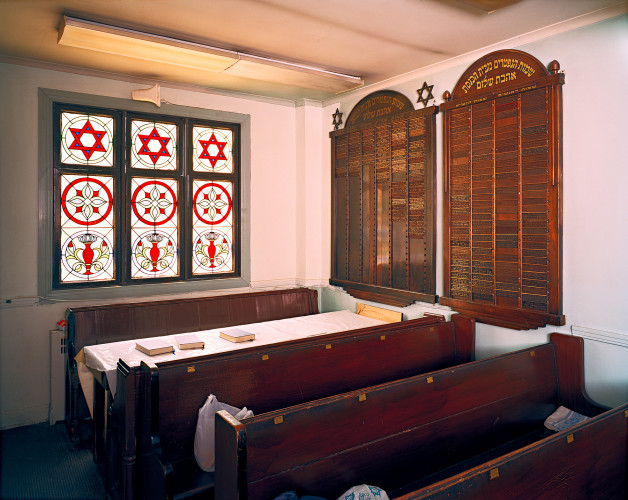by HEATHER SOLOMON
From The Canadian Jewish News, January 10, 2008
The places where we pray are part of us. The physical buildings host baby namings, bar mitzvahs, weddings and Kaddish prayers, as well as community gatherings of dear faces that uphold us through our lifetimes. corporated into its exterior masonry. This is why the exhibition of more than 30 photos that opened in early December and continues until March 18, collectively titled Makom: Seeking Sacred Space, is so very painful to see. It’s also glorious, visually impressive, a source of pride and a vital recording of the imprint of Jewish worship.
That the gallery is inside a vibrant, active shul, Congregation Dorshei Emet (the Reconstructionist Synagogue) makes the display all the more moving.
Two well-known architectural photographers, David Kaufman and David R. Cowles, respectively explore the synagogues of Montreal and North Africa that have fallen into disuse or are on the brink of doing so.
Some have been converted to use for other purposes, a seeming sacrilege, like the former Shomrim Laboker at 3675 St. Dominique St., where the golden glow of the stained glass Stars of David in the vestibule doors bathes pallets of egg crates now stored there. This building, currently a dairy warehouse, also reveals its roots as a shul with the pattern of a huge Magen David incorporated into its exterior masonry.
The old Poale Zedek, likely faced by the same mason, had its brick Magen David scraped down by the Vietnamese temple that took it over in 1992.
Some of the buildings that Kaufman shot would be difficult to identify as one-time synagogues. The former Chevra Kadisha at 5213 Hutchison St. itself took over a Methodist church and reshaped the peaked facade to incorporate a typically Jewish, round-arched roof-line. The Ukrainian National Federation that currently occupies the building, flattened the roof entirely. The Association Portuguese replaced a stained glass Star of David on the former Chevra Shaas with its own emblem.
But Kaufman points out that “a synagogue is not supposed to be an inherently holy building. The ultra-Orthodox set up a shtiebl anywhere, and if anything happens, they run out with the all-important Torah. Even God’s original Temple was only temporary. It’s the history of association that reinforces the special feelings people have for these places. When that disintegrates, the buildings are abandoned.”
Nevertheless, viewers find themselves feeling disturbed and even violated by these local makeovers. Perhaps it also has something to do with our sense of vulnerability in the face of global anti-Semitism, even if these edifices were willingly sold to new tenants.
Cowles, on the other hand, captures what true hostilities have done to synagogue buildings, cemeteries and other Jewish holy sites in North Africa. The Jewish exoduses from Morocco, Egypt and Tunisia came when Israel won the Six Day War, Cowles explains, and Jews were seen as Zionist enemies. “The establishment of Israel ended these communities,” he notes.
The introduction of satellite TV with its news of the second intifadah proved a more recent threat to Jewish architectural legacies, when angry teenagers defaced the shrine of a tzaddik in Tagadiert, Morocco, and terrorists firebombed La Ghriba (The Marvelous), the synagogue in Djerba,Tunisia.
But mostly weather and time have done the damage, as walls collapsed under torrential rains that followed drought, and mould, vines, blankets of dust and invading birds took over once splendid interiors. Cowles still manages to evoke a sense of holiness in the neglect, leaving viewers in awe of the antiquity and beauty of these once active religious places.
Contributing to the historical aura of these images is this photographer’s technique of gold-toned gelatine chloride printing that produces a range of rich browns. Cowles is a Bostonian who moved to Montrealin 1976 to add European and Jewish history studies to his film degree. His historical notes elucidate each photo on the Emet Gallery’s excellent website that presents the exhibition online at www.emetgallery.org. Of course, you must see the lustrous, large-format originals to appreciate their full effect.
Cowles has been travelling to North Africa since 1993, gaining admission to often restricted sites. His work hangs in the National Gallery of Canada,Tel Aviv Museum and the Jewish Museum of Casablanca, among other places.
Kaufman’s brightly coloured, real-tone, incredibly detailed images have their origin in a master’s thesis on synagogues in the Plateau Mont Royal authored by Montrealer Sara Tauben. In 1998, Tauben met Montreal-born Kaufman while he was photographing the KlezKanada festival. She asked the Toronto-based photographer to take pictures for her thesis. He was delighted to return to the haunts of his childhood that he had frequented with his parents. The thesis-writer’s daughter, Evelyn Tauben, is the Emet Gallery’s curator and, armed with a master’s degree in art history from Temple University, Philadelphia, did a stellar job hanging and documenting the show.
Upstairs at Dorshei Emet, Los Angeles’ Benny Ferdman shows, in photos and drawings, how he recreated Jewish prayer spaces in a field outside Jerusalem using trees, rocks and the earth itself. Though these will become dust like the buildings pictured downstairs, Jewish prayer will always find a new home.

A corner for study in the sanctuary of the Nusach Ha’ari – Ahavath Shalom
